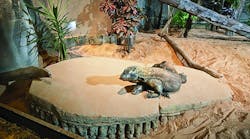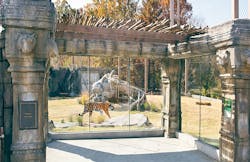Chinese alligators are somewhat smaller cousins to the scaly beasts that threaten a well-aimed chip at any Florida golf course.
Today, due to habitat loss, pollution and invasion of the human species, there are believed to be less than 130 Chinese alligators remaining in the wild – sending them to the top of the critically endangered list.
A few of those living in captivity reside at the Tulsa Zoo. In fact, their lush ecosystem is a brand new, $20 million exhibit that includes an in-slab radiant heating system specifically for their comfort.
Lost Kingdom, found
The Tulsa Zoo opened its gates not quite a century ago. The zoo campus has since grown into an impressive 84 acres with more than 400 animal species organized by different World regions.
In 2012, Zoo managers began development of a 20-year master plan with goals to completely renovate the zoo, section-by-section. The new displays give animals the choice of being indoors or out, with more than 100 square feet of warm areas to bask in year-round, per exhibit, giving guests the opportunity to see them like never before.
“Most zoos locate animal dens out-of-sight, making it difficult for guests to see the animals during certain times of the year,” said Ellen Averill, director of marketing and public relations at Tulsa Zoo. “Our Lost Kingdom exhibits have visible dens, with every comfort for the animals so guests can see them, no matter what the weather is.”
Crocodilian comfort
Chinese alligators prefer a balmier temperature – and the species greatly benefit from parking themselves directly on warmed surfaces (it’s how they regulate body temperature). That’s why, in their new exhibit, there are sources of warmth from three in-slab hydronically-radiant heated “hot rocks” encased in concrete.
“The largest of the Chinese alligator’s concrete radiant zones is covered with a layer of sand, where nesting will take place and females can lay up to 40 eggs,” explained Averill.
To provide them the warmth they so enjoy, the alligator’s hot rocks are heated by 425 lineal feet of ½” Watts Radiant barrier PEX.
“While the entire Chinese alligator exhibit has forced air heat to maintain constant temperatures, animals – like people – prefer to have options,” said Joe Barkowski, Tulsa Zoo’s VP of animal conservation and science. “If they’re too warm, the gators can access the pool. If they’re too cool, they can move to a heated area to absorb the heat directly.”
‘In-slab sensors send signals back to Watts Radiant’s pre-engineered, pre-assembled hydronic control panels.’
Hot rocks and happy critters
The Malayan tiger and Komodo dragon exhibits feature several radiantly-heated hot rocks, both inside and out.
“Komodo dragons (like the ‘gators) are ectotherms, meaning they’re dependent on external sources of body heat, like the sun,” explained Barkowski. “In the wild, they regulate their temperature by basking in sunlight, or seeking shade.”
And, at Tulsa zoo, their artificial option – via temperature-controlled hydronics – works just as well.
Also on the critically endangered list, Malayan tigers come from an equatorial climate where it’s hot and humid throughout the year.
In the exterior exhibits – one for the komodo and two for the tigers – below the surface of the man-made rocks, Watts Radiant ProMelt electric snow and ice melt cable heat the surface, keeping them warm and dry.
According to Greg Sutcliffe, engineer at Tulsa-based Phillips + Gomez, the hot rocks are strategically located to provide optimal viewing for guests while, at the same time, offering animals the chance to seek warmth whenever they like.
More than 50 lineal feet of the ProMelt snowmelt cable is encased in each of the 24 sq.ft. tanning beds, dishing out 50 watts per square foot.
“Typically, out of the factory, ‘cold leads’ – those parts of the wired ProMelt product that do not heat – are ten feet long,” explained Cary Pestel, owner of Tulsa, OK-based Boone & Boone Sales, the manufacturer’s rep firm for the job.
“These lengths of braided steel wire lead to the heating elements of the ProMelt cable,” he continued. “For the job at the zoo, they needed cold leads that were that much longer – fifty feet, in fact. Watts Radiant did that for us; no questions asked.”
“In each of the hot rock applications, dual-sensing tekmar 519 sensors help to govern the temperature of the rocks using pulse width modulation technology – allowing precise control of heat to maintain surface temperatures ideal for the critters,” added Bob Rohde, project manager at Tulsa-based McIntosh Service, LLC, the mechanical subcontractor.
“The tekmar 519s send a signal to a Watts Radiant controller, which activates or deactivates power to the ProMelt wires encased in the concrete,” added Rohde.
“Tulsa winters aren’t anything at all like the Komodo dragon’s natural monsoon climates of Indonesia,” said Barkowski. “Their body temperature is roughly the same as the ambient temperature, so providing them with the warmed rocks is not only necessary for their health; it helps to replicate their natural environment, too.”
Critters warming to improvements
“All of the Lost Kingdom’s interior radiant zones and hot rocks are hydronically heated,” said Pestel. “In-slab sensors send signals back to Watts Radiant’s pre-engineered, preassembled hydronic control panels, which pull water from two, 50-gallon, 40,000 Btu electric water heaters – tasked with heating fluids for all of the interior radiant zones.”
Interior areas of the Malayan tiger exhibits have received in-slab radiant heating, in addition to the exterior hot rocks. There, three separate hydronic radiant heat zones, served by 400 feet of one-half inch RadiantPEX+, provides the tigers with warmth whenever they need it.
Zoo creatures aren’t the only ones pleased with the upgrades – as evidenced by their warming quickly to modern hydronics.
With the animal dens, stalls and dayrooms made visible to guests, opportunities to view animals are greatly improved, year-round. Visitor appreciation of the zoo’s ambitious makeover has been overwhelmingly positive.
So, now, the zoo awaits only one final signal that renovations were spot-on: the hoped-for laying of eggs and the pitter-patter of little Chinese alligator feet across the hot rocks in their new, Oklahoman ecosystem.




